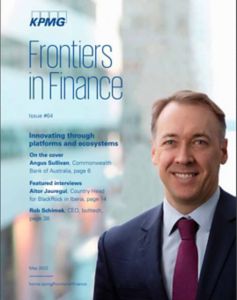Over the last several years, the range of banking products has grown significantly. Fintechs focused on specialized products — such as digital wallets, ‘buy now, pay later’ (BNPL) credit offerings, and banking or lending-as-a-service solutions — have sprung up in almost everywhere, from the United States and China to Australia and Saudi Arabia.
The global pandemic acted as a catalyst for many of these innovative offerings, accelerating uptake as people and businesses abandoned cash and embraced digital payments. The desire of traditional retailers and big techs to extend their customer value into financial services combined with advances in AI, data analytics, and open banking also helped drive interest in alternative banking solutions.
While fintechs continue to play a key role in developing innovative banking products, banks and other financial institutions have not been standing still. But while some large banks and financial institutions have embraced new ways of thinking about product management, others have been stymied by how best to evolve their traditional approach to product development so they can thrive in a data-driven economy.
In the remainder of this article, we highlight the growth of alternative banking products, look at the evolution of how financial products are offered, examine potential opportunities for banks and financial institutions, and offer a place to start for financial institutions wanting to rethink their product management approach
The rise of alternative banking products
Alternative banking products are not new. In China, the use of electronic payments, digital wallets, and installment financing for online purchases has become quite commonplace over the past few years. At the same time, such products have seen an incredible surge in interest since the emergence of COVID-19, particularly in jurisdictions that were not as quick to embrace electronic payments.
Buy now, pay later products are a prime example. One Worldpay/FIS report showed that customers financed approximately US$96 billion in online purchases using BNPL loans in 2020, projecting that the number could rise to US$300 billion globally by 2024.1 In the US specifically, a survey by The Ascent showed the number of consumers using BNPL services rose from 37.6 percent in 2020 to 55.8 percent in 2021, while 53 percent of respondents who had never used BNPL were at least somewhat likely to use it within the next year.2
Interest in BNPL was also visible in the investment space in 2021. During the year, US-based Affirm raised US$1.2 billion in its IPO on the Nasdaq,3 Sweden-based BNPL company Klarna raised US$1.9 billion across two venture capital (VC) funding rounds,4 and US-based Square acquired Australia-based Afterpay for US$29 billion.5
The global pandemic acted as a catalyst for many of these innovative offerings, accelerating uptake as people and businesses abandoned cash and embraced digital payments.
A rapid evolution in the offering of financial products
The financial services industry globally is not homogenous, with many jurisdictions taking unique approaches to the regulation of fintechs or to the regulation of financial products. Despite sometimes radically different regulatory environments, however, it is clear that the pandemic has shifted the foundation of financial services in many parts of the world, driving demand for digital products.
This shift in demand, in addition to the rapid acceleration in digitalization among companies across sectors, has put a spotlight on the fact that almost any company or brand can integrate financial products within their business model or use their customer data to provide convenient and personalized financial products.
Numerous non-financial companies are doing just that. In 2021 alone, Walmart announced a strategic partnership with Ribbit Capital to provide tailored financial experiences to their customers,6 Walgreens announced plans to offer digital bank accounts through a partnership with MetaBank,7 and IKEA acquired a 49 percent stake in its financial services partner Ikano Bank as part of its plans to expand consumer banking services.8
While fintechs and non-financial companies are helping fuel the shift in how financial products are offered in some countries, in others, government initiatives are shaping the evolution. For example, the introduction of a central bank digital currency (e-CNY) by the Central Bank of China is expected to encourage traditional financial institutions in the country to provide digital wallet solutions aligned with the e-CNY — whereas historically digital wallets were primarily offered by fintechs and third-party payments companies.
Looking beyond current challenges
Given changing customer demands and a growing number of nonfinancial companies providing financial products, many banks and financial institutions are facing pressure to adapt their approaches to product management in order to retain their market share and customers.
While they may be under intense pressure, financial institutions should recognize that the current environment isn’t only throwing up challenges; it’s also providing opportunities. While the opportunities in specific jurisdictions might be very different, examples might include:
From a banking standpoint, the lines across traditional credit products are already blurring, while underwriting should be agnostic of the product through which credit is being delivered (e.g., BNPL, personal loans, credit cards). Banks that have a strong relationship orientation to credit versus a product orientation to credit and that can manage economics and risk effectively will likely have an advantage when it comes to providing or supporting alternative financial products.
Often, banks or other financial institutions are only involved at the point of need for their customers. Banks have an opportunity to differentiate themselves by engaging more holistically across their customers’ purchasing journeys so that customers receive targeted and personalized content when it is most useful to them.
Banks have a unique opportunity to work with partners to provide unique offerings — similar to how fintechs often work with non-financial companies. For example, working with small ticket BNPL companies to originate higher ticket items, partnering with marketplaces or merchants on lending-as-a-service platforms, or providing non-financial companies with banking-as-a-service platforms.
Reimaging financial product management
Before building new financial products, work to understand your customers so that you can align activities directly to your proposed value offering. Then, as you begin to build and offer new products, keep taking the pulse of your customers so you can see how they respond, identify their potential pain points, and adjust course as needed. Throughout, make sure you have a robust approach to data so that you can make data-driven decisions and use data to enhance the value of your offerings.
Traditional methods of product development won’t be as relevant in the future given how customer demand and purchasing behaviors are evolving. To be relevant to your customers, focus on understanding the customer experience that they want and engage with them where they want you to be.
In the future, partnerships or acquired capabilities will likely be what differentiate financial institutions. With the right partners, you can build a stronger understanding of your customers, provide relevant and personalized services, and more readily engage in the purchasing journey. As you imagine the future, consider how partners can fit within your ecosystem and how you can fit within the ecosystems of others in order to provide the integration and relevance your customers want.
The COVID-19 pandemic may have acted as an accelerant for digital innovation in the financial services sector, but there’s no stopping the new trajectory now. If anything, it’s even more important for banks and financial institutions to reimagine their product management approach so they can thrive in the post-COVID world — a world where speed, agility, and data-driven insights are expected to be integral for meeting the ever-changing needs of customers.
This article is featured in Frontiers in Finance – Resilient and relevant
Explore other articles › Subscribe to receive the latest financial services insights directly to your inbox ›
Connect with us
- Find office locations kpmg.findOfficeLocations
- kpmg.emailUs
- Social media @ KPMG kpmg.socialMedia
Stay up to date with what matters to you
Gain access to personalized content based on your interests by signing up today
Explore more chapters
1 https://www.reuters.com/breakingviews/breakdown-buy-now-pay-laters-bill-is-coming-due-2021-10-14/
2 https://www.fool.com/the-ascent/research/buy-now-pay-later-statistics/
3 https://www.nasdaq.com/articles/affirm-prices-u.s.-ipo-above-target-range-raises-%241.2-bln-sources-2021-01-12
4 https://assets.kpmg/content/dam/kpmg/xx/pdf/2021/08/pulse-of-fintech-h1.pdf
5 https://www.cnn.com/2021/08/01/tech/square-afterpay-intl-hnk/index.html
6 https://corporate.walmart.com/newsroom/2021/01/11/walmart-announces-creation-of-new-fintech-startup
7 https://www.bankingdive.com/news/walgreens-to-launch-digital-bank-accounts-this-year/597645/
8 https://www.theguardian.com/business/2021/feb/11/ikea-to-offer-financial-services-in-store-after-deal-with-ikano-bank






